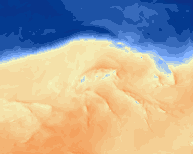
Our snow maps for the next 6 days are still empty, but that will soon change. First, we’ll look at the current conditions and then take a look at several weather models, all of which predict positive changes in the new year.
Avalanche risk gradually decreasing
Stunning images have appeared online over the past few days of deep powder descents and cliff jumps with soft landings. Unfortunately, things also went wrong in some places, with multiple avalanche fatalities during the Christmas holidays. The snowpack is now gradually becoming more stable, but on steeper slopes, the danger remains high for the time being.
Check the temperature at 1500 meter for the coming days:
Mild and sunny, snow quality remains quite good
On Thursday, mild air already arrived in the Pyrenees and French Alps, with temperatures reaching +10°C at 1500 meters. This afternoon and in the coming days, we can expect similar temperatures across the rest of the Alps, with positive highs reaching up to 3000 meters. However, the air remains very dry, with dew points consistently staying below freezing. This, combined with the low angle of the sun, ensures that snow on shaded slopes stays powdery for a long time. On south-facing slopes, the sun does impact the snowpack, which refreezes at night, leading to harder snow and possible crust formation. In the deepest valleys, fog and low cloud can linger all day (see the Rhine Valley in the webcam image above), keeping temperatures barely above freezing.

Shift likely with snow from 2 or 3 January
Over the past few days, it was difficult to make meaningful predictions about the weather in the new year, as the weather models and ensemble forecasts varied widely. The common theme, however, is a high-pressure ridge over the ocean, pushing colder air and disturbances southward. While the shift is still relatively far off, we can at least explore the scenarios that the different main runs of the weather models are now presenting:
- ECMWF: Snow in the western and northern Alps starting Friday, January 3, above 500–1000 meters. High pressure west of Ireland and low pressure over Scandinavia.
- GFS: Snow in the western and northern Alps starting Thursday, January 2, above 500–1300 meters. Similar pressure pattern to ECMWF, but with earlier snowfall.
- UKMO: Similar timing and pressure distribution as GFS. UKMO also shows a Genoa low, with snow chances for the southern Alps.
- GEM: Initial precipitation on Thursday, January 2, with rain below 1500 meters and snow on January 3 and 4. GEM, like the other models, indicates the heaviest precipitation in the western and northern Alps.
From January 4 or 5, all weather models show a high-pressure ridge extending from the ocean over the Alps, reducing the likelihood of further snowfall.


